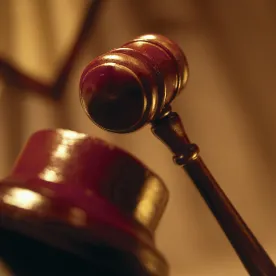Spoofing is not going away after all. Last week, the U.S. Court of Appeals for the Seventh Circuit unanimously upheld the first-ever criminal conviction for spoofing. The case, United States v. Coscia, 7th U.S. Circuit Court of Appeals, No. 16-3017, involved a multi-count indictment against futures trader Michael Coscia. The indictment alleged that Coscia engaged in illegal trading by employing computer algorithms that engaged in market activity that violated the anti-spoofing laws created and adopted as part of the Dodd-Frank Wall Street Reform and Consumer Protection Act of 2010. The indictment alleged that Coscia traded in a variety of futures products and made over $1.4 million as a result of his illegal trading.
By way of background, spoofing involves placing bids or offers to sell futures contracts with the intent to cancel the bids or offers before execution. By placing bids or offers, which were never intended to be executed, “spoofers” create an illusion of supply or demand that can influence prices to benefit their other positions in the markets. Accordingly, Coscia placed small orders on one side of the market and then rapidly placed large orders on the opposite side to create the appearance of increased volume pressure. This apparent increased volume on the opposite side caused other market participants to trade against Coscia’s small orders. Coscia then cancelled the large “spoof” orders, which he had never intended to be executed in the first place.
After a seven-day long trial in November 2015, an Illinois federal jury found Coscia guilty of all counts in the indictment. In July 2016, the Honorable Harry D. Leinenweber sentenced Coscia to three years in prison and two years of supervised release. Coscia is currently serving his sentence in a New Jersey federal prison. On appeal, Coscia and his lawyers argued that: the anti-spoofing statute was unconstitutionally vague; there was insufficient evidence at trial to support the conviction; and the district court erred in sentencing by improperly measuring the amount of the loss. The remainder of this article focuses on the Seventh Circuit’s denial of Coscia’s first two arguments.
The constitutionality of the spoofing laws has remained controversial since their adoption. Now, however – with a unanimous opinion – the Seventh Circuit has upheld their constitutionality. In fact, the language of the opinion so clearly supports constitutionality that the panel appears dismissive of Coscia’s arguments. “The anti‐spoofing provision provides clear notice and does not allow for arbitrary enforcement,” U.S. Circuit Judge Kenneth Ripple wrote. “Consequently, it is not unconstitutionally vague.” United States v. Coscia, No. 16-3017, 2017 WL 3381433 at *1, — F.3d – (7th Cir. Aug. 7, 2017), available here.
The Seventh Circuit also held that based on the evidence presented at trial, a reasonable trier of fact could have concluded that Coscia had the requisite intent. The Seventh Circuit specifically reviewed the evidence of Coscia’s purposeful design and use of two computer algorithmic trading programs which were designed to repeatedly place small buy or sell orders in the market, followed by the rapid placement and cancellation of large orders on the opposite side of the market of his small orders. The Seventh Circuit pointed to the testimony of the designer of Coscia’s computer algorithms, as evidence of Coscia’s intent. At trial, this witness explained that the programs he designed for Coscia were meant to “act like a decoy.” Id. at *4. Although the Seventh Circuit noted that there was not a “single piece of evidence” (id. at *10) that necessarily established spoofing, it concluded that based on the totality of the evidence at trial, a rational trier of fact could conclude that “Mr. Coscia engaged in this behavior in order to inflate or deflate the price of certain commodities,” and “[h]is trading accordingly also constituted commodities fraud[.]” Id. at *15.
While the Seventh Circuit did not provide specific factors or elements to be cited to in the future regarding spoofing, the Seventh Circuit did detail its analysis of the evidence to support its affirmation of the conviction.
A review of the trial evidence reveals the following. First, Mr. Coscia’s cancellations represented 96% of all Brent futures cancellations on the Intercontinental Exchange during the two‐month period in which he employed his software. Second, on the Chicago Mercantile Exchange, 35.61% of his small orders were filled, whereas only 0.08% of his large orders were filled. Similarly, only 0.5% of his large orders were filled on the Intercontinental Exchange. Third, the designer of the programs, Jeremiah Park, testified that the programs were designed to avoid large orders being filled. Fourth, Park further testified that the “quote orders” were “[u]sed to pump [the] market,” suggesting that they were designed to inflate prices through illusory orders. Fifth, according to one study, only 0.57% of Coscia’s large orders were on the market for more than one second, whereas 65% of large orders entered by other high‐frequency traders were open for more than a second. Finally, Mathew Evans, the senior vice president of NERA Economic Consulting, testified that Coscia’s order‐to‐trade ratio was 1,592%, whereas the order‐to‐trade ratio for other market participants ranged from 91% to 264%. As explained at trial, these figures “mean[] that Michael Coscia’s average order [was] much larger than his average trade”—i.e., it further suggests that the large orders were placed, not with the intent to actually consummate the transaction, but rather to shift the market toward the artificial price at which the small orders were ultimately traded.
We believe that, given this evidence, a rational trier of fact easily could have found that, at the time he placed his orders, Mr. Coscia had the “intent to cancel before execution.” (emphasis added). Id. at *10.
In conclusion, the Seventh Circuit’s opinion provides us with several takeaways:
-
Spoofing is not going away, and this ruling will embolden prosecutors and the futures regulators. This likely qualifies as the most successful prosecution to date by the Securities and Commodities Fraud Section at the U.S. Attorney’s Office for the Northern District of Illinois. That said, criminal investigations and prosecutions require proving violations beyond a reasonable doubt. Thus, any potential uptick in spoofing criminal cases will be tempered accordingly. Regarding the U.S. Commodity Futures Trading Commission (“CFTC”) and the futures self-regulatory organizations, such as the Chicago Mercantile Exchange and the Intercontinental Exchange, they will continue to prioritize aggressively investigating and civilly prosecuting spoofing through their enforcement programs in light of this ruling.
-
The increased regulatory and industry emphasis on trading surveillance will continue to accelerate. For those market participants with a business model that presents a greater risk of being subjected to these investigations – if not already doing so – they need to consider implementing a trading surveillance system. Several fintech firms provide surveillance systems to market participants and other market participants (with the resources and capabilities) have developed proprietary systems internally. While not currently a regulatory requirement, the CFTC has sent messages via its enforcement program emphasizing trading surveillance by including it as part of the undertakings in two of its high-profile spoofing settlements this past year.
-
Lastly, as mentioned above, the Seventh Circuit did not provide factors or elements, but did detail the evidence that supported the conviction. In addition to the witness testimony, the Seventh Circuit discussed two quantifiable metrics that market participants can use to monitor and detect potential manipulative activity. These two metrics are the: 1) order-to-trade ratio; and 2) order duration. First, the order-to-trade compares the amount of orders entered to the amount of executed trades. Two aspects of this ratio worked to Coscia’s detriment; a) his order-to trade ratio exponentially exceeded the ratios for other market participants; and b) the large lot sizes for his placed and cancelled orders routinely and significantly exceeded the small lots sizes for his executed trades. Second, regarding order duration, the Seventh Circuit found that according to one study only 0.57% of Coscia’s large orders rested in the market for more than one second, whereas 65% of large orders entered by other high-frequency traders remained open in the market for more than one second. Thus, when compared to other market participants, the lower the order-to-trade ratio and the longer the order duration, the stronger the arguments that market participants will have to attempt to avoid investigation and prosecution. While algorithmic, high-frequency trading is very complex, these two metrics are fairly straightforward and implementing and monitoring these metrics may provide market participants with defenses to avoid a similar fate.




 />i
/>i

